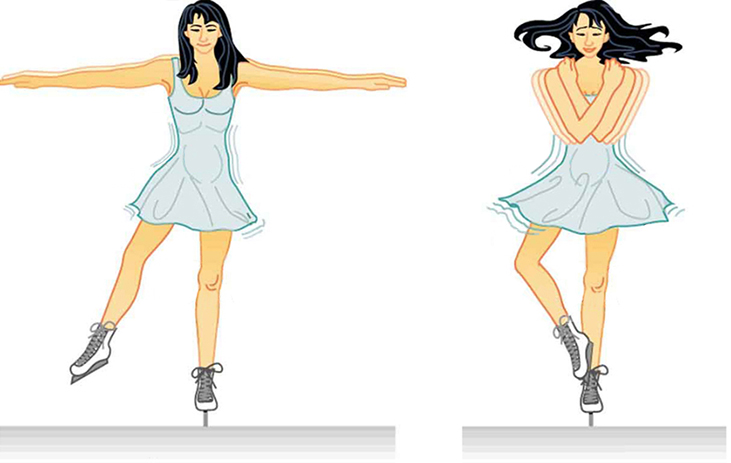| << Chapter < Page | Chapter >> Page > |
This means that forces in nature do not occur alone: we find that in each situation there is always a pair of forces that are equal to and opposite each other. If a force is exerted on an object, it must be exerted by something else, and the object will exert an equal and opposite force back on that something. We can look at a simple example to demonstrate this.
Suppose that a daredevil astronomy student—and avid skateboarder—wants to jump from his second-story dorm window onto his board below (we don’t recommend trying this!). The force pulling him down after jumping (as we will see in the next section) is the force of gravity between him and Earth. Both he and Earth must experience the same total change of momentum because of the influence of these mutual forces. So, both the student and Earth are accelerated by each other’s pull. However, the student does much more of the moving. Because Earth has enormously greater mass, it can experience the same change of momentum by accelerating only a very small amount. Things fall toward Earth all the time, but the acceleration of our planet as a result is far too small to be measured.
A more obvious example of the mutual nature of forces between objects is familiar to all who have batted a baseball. The recoil you feel as you swing your bat shows that the ball exerts a force on it during the impact, just as the bat does on the ball. Similarly, when a rifle you are bracing on your shoulder is discharged, the force pushing the bullet out of the muzzle is equal to the force pushing backward upon the gun and your shoulder.
This is the principle behind jet engines and rockets: the force that discharges the exhaust gases from the rear of the rocket is accompanied by the force that pushes the rocket forward. The exhaust gases need not push against air or Earth; a rocket actually operates best in a vacuum ( [link] ).

For more about Isaac Newton’s life and work, check out this timeline page with snapshots from his career, produced by the British Broadcasting Corporation (BBC).
Before we go on to discuss Newton’s other work, we want to take a brief look at some terms that will be important to sort out clearly. We begin with mass, which is a measure of the amount of material within an object.
The volume of an object is the measure of the physical space it occupies. Volume is measured in cubic units, such as cubic centimeters or liters. The volume is the “size” of an object. A penny and an inflated balloon may both have the same mass , but they have very different volumes. The reason is that they also have very different densities , which is a measure of how much mass there is per unit volume. Specifically, density is the mass divided by the volume. Note that in everyday language we often use “heavy” and “light” as indications of density (rather than weight) as, for instance, when we say that iron is heavy or that whipped cream is light.
The units of density that will be used in this book are grams per cubic centimeter (g/cm
3 ).
Generally we use standard metric (or SI) units in this book. The proper metric unit of density in that system is kg/m
3 . But to most people,
g/cm
3 provides a more meaningful unit because the density of water is exactly 1 g/cm
3 , and this is useful information for comparison. Density expressed in g/cm
3 is sometimes called specific density or specific weight. If a block of some material has a mass of 300 grams and a volume of 100 cm
3 , its density is 3 g/cm
3 . Familiar materials span a considerable range in density, from artificial materials such as plastic insulating foam (less than 0.1 g/cm
3 ) to gold (19.3 g/cm
3 ).
[link] gives the densities of some familiar materials. In the astronomical universe, much more remarkable densities can be found, all the way from a comet’s tail (10
–16 g/cm
3 ) to a collapsed “star corpse” called a neutron star (10
15 g/cm
3 ).
| Densities of Common Materials | |
|---|---|
| Material | Density (g/cm 3 ) |
| Gold | 19.3 |
| Lead | 11.3 |
| Iron | 7.9 |
| Earth (bulk) | 5.5 |
| Rock (typical) | 2.5 |
| Water | 1 |
| Wood (typical) | 0.8 |
| Insulating foam | 0.1 |
| Silica gel | 0.02 |
To sum up, mass is how much , volume is how big , and density is how tightly packed .
You can play with a simple animation demonstrating the relationship between the concepts of density, mass, and volume, and find out why objects like wood float in water.
A concept that is a bit more complex, but important for understanding many astronomical objects, is angular momentum , which is a measure of the rotation of a body as it revolves around some fixed point (an example is a planet orbiting the Sun). The angular momentum of an object is defined as the product of its mass, its velocity, and its distance from the fixed point around which it revolves.
If these three quantities remain constant—that is, if the motion of a particular object takes place at a constant velocity at a fixed distance from the spin center—then the angular momentum is also a constant. Kepler’s second law is a consequence of the conservation of angular momentum . As a planet approaches the Sun on its elliptical orbit and the distance to the spin center decreases, the planet speeds up to conserve the angular momentum. Similarly, when the planet is farther from the Sun, it moves more slowly.
The conservation of angular momentum is illustrated by figure skaters, who bring their arms and legs in to spin more rapidly, and extend their arms and legs to slow down ( [link] ). You can duplicate this yourself on a well-oiled swivel stool by starting yourself spinning slowly with your arms extended and then pulling your arms in. Another example of the conservation of angular momentum is a shrinking cloud of dust or a star collapsing on itself (both are situations that you will learn about as you read on). As material moves to a lesser distance from the spin center, the speed of the material increases to conserve angular momentum.

In his Principia , Isaac Newton established the three laws that govern the motion of objects: (1) objects continue to be at rest or move with a constant velocity unless acted upon by an outside force; (2) an outside force causes an acceleration (and changes the momentum) for an object; and (3) for every action there is an equal and opposite reaction. Momentum is a measure of the motion of an object and depends on both its mass and its velocity. Angular momentum is a measure of the motion of a spinning or revolving object and depends on its mass, velocity, and distance from the point around which it revolves. The density of an object is its mass divided by its volume.

Notification Switch
Would you like to follow the 'Astronomy' conversation and receive update notifications?